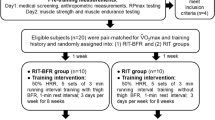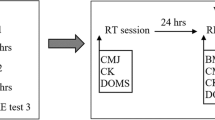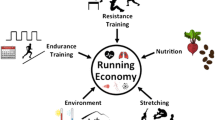Abstract
Purpose
Training with blood flow restriction (BFR) is known to enhance muscle mass and strength during resistance training activities. However, little is known about the BFR effects during aerobic training. This investigation examines the effects of running training performed with or without BFR on physiology and performance.
Method
Sixteen subjects (age 24.9 ± 6.9 years, height 172.9 ± 7.8 cm, weight 75.1 ± 13.8 kg) were assigned to a BFR or control (CON) group for eight sessions of training. Before and after training, subjects completed an incremental test to determine peak running velocity (PRV) maximal oxygen uptake (\(\dot {V}{{\text{O}}_{2\hbox{max} }}\)) and running economy (RE), followed by a time to exhaustion run (TTE) performed at PRV. Training for both groups consisted of progressively increasing volumes of 30-s repetitions completed at 80% of PRV.
Results
The BFR and CON groups reported gains (6.3 ± 3.5 vs 4.0 ± 3.3%) in \(\dot {V}{{\text{O}}_{2\hbox{max} }}\) following training with only trivial (ES = 0.18) differences between groups. Similarly, PRV and incremental test time increased in both training groups with a small (ES ~ 0.3) additional enhancement in favour of the BFR group. Running economy improved in the BFR group but not in CON (ES = 0.4). TTE also increased in both BFR (27 ± 9%) and CON groups (17 ± 6%) with a small (ES = 0.31) additional benefit in favour of the BFR group.
Conclusions
Using BFR during training appears to confer small but potentially worthwhile improvements in RE, PRV and TTE measures. The improvements following BFR training are likely due to muscular rather than cardiovascular function.
Similar content being viewed by others
Abbreviations
- ANOVA:
-
Analysis of variance
- BFR:
-
Blood flow restriction
- CI:
-
Confidence interval
- CON:
-
Control
- EMG:
-
Electromyography
- ES:
-
Effect size
- HR:
-
Heart rate
- PRV:
-
Peak running velocity
- RE:
-
Running economy
- TTE:
-
Time to exhaustion
- \(\dot {V}{{\text{O}}_{2\hbox{max} }}\) :
-
Maximum oxygen uptake
References
Abe T, Yasuda T, Midorikawa T, Sato Y, Kearns C, Inoue K, Koizumi K, Ishii N (2005) Skeletal muscle size and circulating IGF-1 are increased after two weeks of twice daily “KAATSU” resistance training. Int J KAATSU Train Res 1(1):6–12
Abe T, Keams C, Sato Y (2006) Muscle size and strength are increased following walk training with restricted venous blood flow from the leg muscles. J Appl Physiol 100(5):1460–1466
Abe T, Fujita S, Nakajima T, Sakamaki M, Ozaki H, Ogasawara R, Sugaya M, Kudo M, Kurano M, Yasuda T, Sato Y, Ohshima H, Mukai C, Ishii N (2010) Effects of low-intensity cycle training with restricted leg blood flow on thigh muscle volume and VO2max in young men. J Sports Sci Med 9(3):452–458
Beavan M, Cook C, Gill N (2008) Significant strength gains in rugby players after specific resistance exercise protocols based on individual salivary testosterone responses. J Strength Cond Res 22(2):419–425
Cohen J (1988) Statistical power analysis for the behavioural sciences. Lawrence Erlbaum, Mahwah
Cook C, Kilduff L, Beaven M (2014) Improving strength and power in trained athletes with 3 weeks of occlusion training. Int J Sports Physiol Perform 9:166–172
de Oliveira M, Caputo F, Corvino R, Denadai B (2016) Short-term low-intensity blood flow restricted interval training improves both aerobic fitness and muscle strength. Scand J Med Sci Sports 26(9):1017–1025
Hopkins W (2006) Spreadsheets for analysis of controlled trials, with adjustments for a subject characeristic. Sportscience 10:46–50. http://sportsci.org/2006/wghcontrial.htm. Accessed 29 Mar 2017
Jones A, Doust J (1996) A 1% treadmill grade most accurately reflects the energetic cost of outdoor running. J Sports Sci 14(4):321–327
Keramidas M, Kounalakis S, Geladas N (2012) The effect of interval training combined with thigh cuffs pressure on maximal and submaximal exercise performance. Clin Physiol Funct Imaging 32(3):205–213
Laurentino G, Ugrinowitsch C, Aihara A, Fernandes A, Parcell A, Tricoli V (2008) Effects of strength training and vascular occlusion. Int J Sports Med 29(8):664–667
Loenneke J, Pujol T (2009) The use of occlusion training to produce muscle hypertrophy. Strength Cond J 31:77–84
Loenneke JP, Thrower AD, Balapur A, Barnes JT, Pujol TJ (2011) The energy requirements of walking with restricted blood flow. Sport Science 4(2):7–11. http://www.sposci.com/TEXT/TxAr0402.html. Accessed 29 Mar 2017
Loenneke J, Fahs C, Rossow L, Sherk V, Thiebaud R, Abe T, Bemben D, Bemben M (2012) Effects of cuff width on arterial occlusion: implications for blood flow restricted exercise. Eur J Appl Physiol 112(8):2903–2912
Park S, Kim J, Choi H, Kim H, Beekley M, Nho H (2010) Increase in maximal oxygen uptake following 2-week walk training with blood flow occlusion in athletes. Eur J Appl Physiol 109(4):591–600
Paton CD, Hopkins WG (2004) Effects of high-intensity training on performance and physiology of endurance athletes. Sportscience 8:25–40. http://sportsci.org/jour/04/cdp.htm. Accessed 29 Mar 2017
Pope Z, Willardson J, Schoenfield B (2013) A brief review: exercise and blood flow restriction. J Strength Cond Res 27(10):2914–2926
Suga T, Okita K, Morita N, Yokota T, Hirabayashi K, Horiuchi M, Takada S, Takahashi T, Omokawa M, Kinugawa S, Tsutsui H (2009) Intramuscular metabolism during low-intensity resistance exercise with blood flow restriction. J Appl Physiol 106(4):1119–1124
Takano H, Morita T, Iida H, Asada K, Kato M, Uno K, Hirose K, Matsumoto A, Takenaka K, Hirata Y, Eto F, Nagai R, Sato Y, Nakajima T (2005) Hemodynamic and hormonal responses to a short-term low-intensity resistance exercise with the reduction of muscle blood flow. Eur J Appl Physiol 95(1):65–73
Wernbom M, Augustsson J, Thomeé R (2006) Effects of vascular occlusion on muscular endurance in dynamic knee extension exercise at different submaximal loads. J Strength Cond Res 20(2):372–377
Wernbom M, Järrebring R, Andreasson M, Augustsson J (2009) Acute effects of blood flow restriction on muscle activity and endurance during fatiguing dynamic knee extensions at low load. J Strength Cond Res 23(8):2389–2395
Wilson J, Lowery R, Joy J, Loenneke J, Naimo M (2013) Practical blood flow restriction training increases acute determinants of hypertrophy without increases indices of muscle damage. J Strength Cond Res 27(11):3068–3075
Yasuda T, Brechue W, Fujita T, Shirakawa J, Sato Y, Abe T (2009) Muscle activation during low-intensity muscle contractions with restricted blood flow. J Sports Sci 27(5):479–489
Yasuda T, Ogasawara R, Sakamaki M, Bemben M, Abe T (2011) Relationship between limb and trunk muscle hypertrophy following high-intensity resistance training and blood flow-restricted low-intensity resistance training. Clin Physiol Funct Imaging 31(5):347–351
Author information
Authors and Affiliations
Corresponding author
Ethics declarations
Conflict of interest
The authors declare they have no conflict of interest.
Ethical approval
All procedures performed in studies involving human participants were in accordance with the ethical standards of the institutional and/or national research committee and with the 1964 Helsinki declaration and its later amendments or comparable ethical standards.
Additional information
Communicated by Carsten Lundby.
Electronic supplementary material
Below is the link to the electronic supplementary material.
Rights and permissions
About this article
Cite this article
Paton, C.D., Addis, S.M. & Taylor, LA. The effects of muscle blood flow restriction during running training on measures of aerobic capacity and run time to exhaustion. Eur J Appl Physiol 117, 2579–2585 (2017). https://doi.org/10.1007/s00421-017-3745-3
Received:
Accepted:
Published:
Issue Date:
DOI: https://doi.org/10.1007/s00421-017-3745-3




